
|
National Panasonic RF-1150
"Cougar 115"
Portable Shortwave Receiver
|
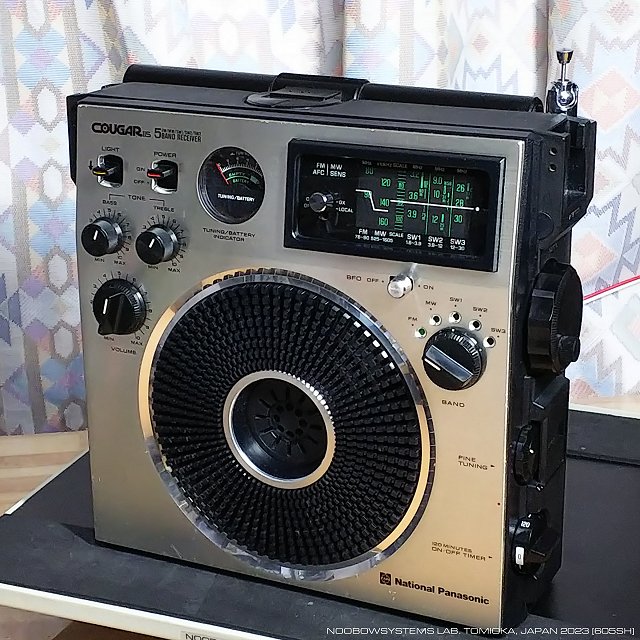
|
|
For those who spent radio kids life in the fanatic shortwave boom in 1970s,
these two names would never be forgotten; the Sony SkySensor and National Cougar. Cougar series portables started with a model "original Cougar", which had a big front firing speaker and all the controls were located on the top panel. "Cougar No. 7" introduced a "Gyro Antenna". It was a ferrite bar antenna which could be rotated 180 degrees so that the user could aim the desired AM stations, or to reject unwanted interference signal. If you think about the geographic circumstance of Japan - Korean peninsula is pretty close, Mainland China is only one hop away, and there are bunch of domestic local AM stations - every night the AM dial is filled with stations and stations. For younger generation to enjoy their favorite midnight talk show, interference rejection capability was indeed appreciated. Shortwave was not the priority in those early Cougar series. As the shortwave boom became hot, Panasonic introduced the Cougar 115, to compete with its rival Sony SkySensor 5800. "National" was the domestic brand name of Matsushita Electric. Matsushita then started to introduce "Panasonic" name also in Japanese domestic market, but for us at that time we were too accustomed with "National" name --- we radio kids never knew there's another National who had been producing marvelous communication equipment in the U.S. |
|
|
Okay let's start the quick check of this 115 I recently acquired.
It has no missing outfit.
Many scratches but none of them degrades the overall appearance.
Battery compartment suffered battery corrosion, but can be cleaned.
With fresh batteries installed, the radio started to operate.
Volume control may need to be replaced as it is too much scratchy --
it only plays when the control is at more than half loud --
the audio output is ample.
Cleaning up the band switch contact is necessary, but the sensitivity seems to be excellent. Main tuning dial works smoothly. BFO also works, it picked up some JA stations rag chewing on the 14MHz band although the stability is inadequate for SSB monitoring. Conclusion of the initial diagnosis: regular cleaning procedure required. Try reviving the audio volume. If it is not successful, replace it. |
|
|
Removing 4 screws, the front panel and back panel can be easily removed.
All of the components are neatly mounted on the main (center) frame.
Front panel carries a 16cm speaker.
It seems that the previous owner never opened the unit.
Accumulated dust and remaining of small lifeform activity are visible; all within the expected range. The RF-1150 has two circuit boards on which total of 2 FETs and 21 transistors are mounted. Left side board (when viewed from front) contains audio circuits and power supply, whereas the right board carries high frequency circuits. AC power transformer is mounted at the bottom. Metallic sheet cover of front panel is electrically connected to the speaker frame , then grounded to the circuit board. I see the honesty of the designer; trying to reduce the problems of the unshielded plastic case. The interior of the radio was dusty, as shown on the right. |
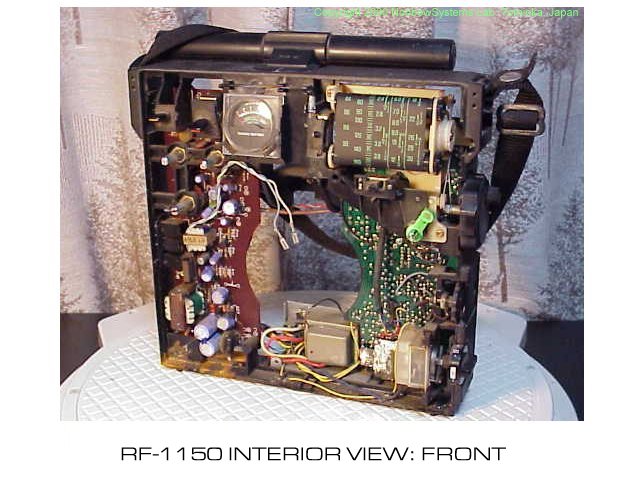 |
|||
|
Applying a shot of "Safe Wash" spray, the audio volume control regained smooth operation.
Bass/Treble tone control revived also.
The audio volume control is not a regular 3 terminal potentiometer;
it has extra terminal at the opposite side of the center (brush) terminal.
It might be a special design for the loudness circuit,
but I did not trace the circuit further since there was no longer the necessity of replacing it. Band selection switch is a long slide switch, operated by the rotating action of the BAND knob. I could not find an easy spot for applying the Safe Wash. The switch gradually regained smoothness without any special treatment so I left it. Front and rear cover were cleaned thoroughly with soap and warm water. Internal components and center frame was brushed softly. The battery leak remaining was cleaned with SimpleGreen and other chemicals. Surprisingly the radio did not require any electrical servicing. Applied the Kure PolyMate (similar product to ArmourAll in the U.S.) to the outer plastics, the radio became like-new-at-a-grance condition. The easy restoration project is now completed. |
 |
|
Band Arrangement and Dial Mechanism Band arrangement is as follows;
Main tuning knob is on the right side of the body. The plastic film dial is string driven. Tuning knob rotates 4 1/2 for entire dial span; i.e. reduction ratio is 1:9. it requires delicate operation even for the international broadcast stations. The dial is crowded even in 31 meter band (9.5-10MHz). Reading the current frequency is almost impossible. As for the dial readout, it is no better than Hallicrafters S-38. When this model appeared on the market, Sony and Panasonic were developing their newer models with direct frequency readout capability; ICF-5900 and RF-2200. Reportedly the U.S. version has an extra CB band, making the receiver total of 6 bands. CB band can be selected by an extra switch (same as the BFO switch) located right above the band selector. I was happy when I found the film dial mechanism had been maintaining its smooth operation. The unit keeps the most important point of the shortwave receiver. 115 does not have a transparent plastic "light duct". |
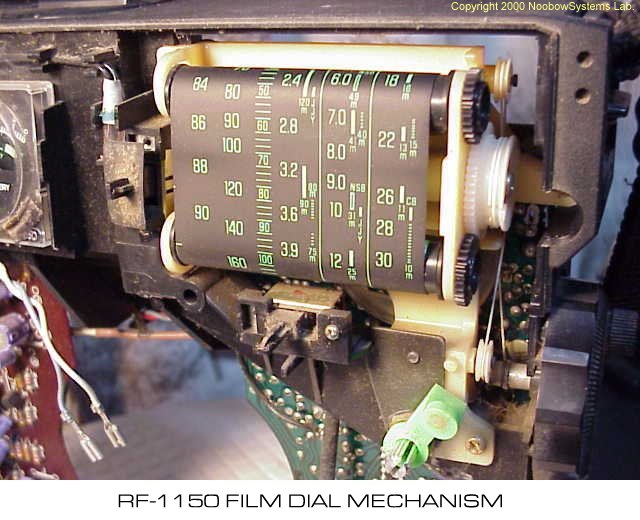 |
|||||||||||||||||||||||||||||||||||||||||||||||||||||||||||||||||||||||||
Dial accuracy is satisfactory when the class this receiver belongs to is considered.
The sensitivity is fine for any part of the band,
as shown in the table.
It shows the minimum output of my signal generator in order to copy the signal.
Note that this is a quick test; not an academic way.
FM-AFC/MW-SENS Switch This slide switch works as AFC ON/OFF on the FM band, and as the sensitivity control on the MW (BC) band. On shortwave band it does not do anything. BFO Switch Sliding this switch to ON turns on the BFO for CW or SSB reception. |
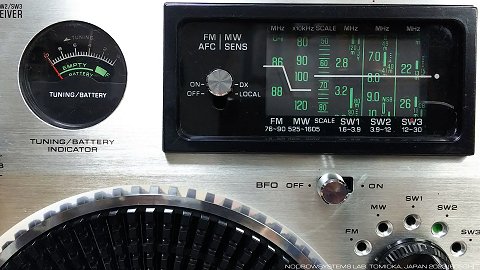 |
|||||||||||||||||||||||||||||||||||||||||||||||||||||||||||||||||||||||||
|
Fine Tuning FINE TUNING will be appreciated in shortwave tuning. It is on the right side panel. A flat knob can be rotated freely, but only 180 degrees are effective. It does not provide any logging scale. The Fine Tuning control is actually a very small trimmer capacitor, and I guess it varies the local oscillator frequency; It's the simplest and cheapest trick but it certainly a good supplement to the too quick main tuning. |
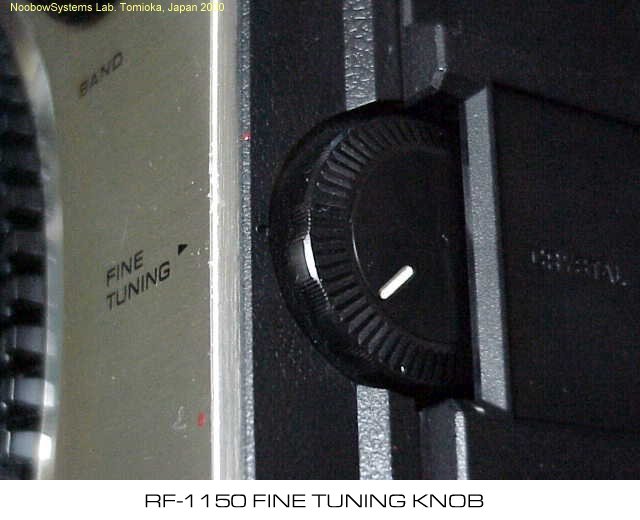   |
|||||||||||||||||||||||||||||||||||||||||||||||||||||||||||||||||||||||||
|
Tuning / Battery Indicator This is a non calibrated S-meter, indicating the relative signal strength. The pointer goes leftward on the strong signal, goes right on the weak or no signal. Battery voltage may be checked if the pointer is within the "battery F" green belt region, when no signal is being received. This pointer movement is typical to Panasonic radios, which is opposite to the ordinary S-meter arrangement. For this particular unit, the battery indicator is on the lower edge of the "good" range when the battery voltage is approx. 3.3V. The radio keeps reasonable operation even with such weak battery. When the battery voltage drops to 3.0V, the radio becomes silent. |
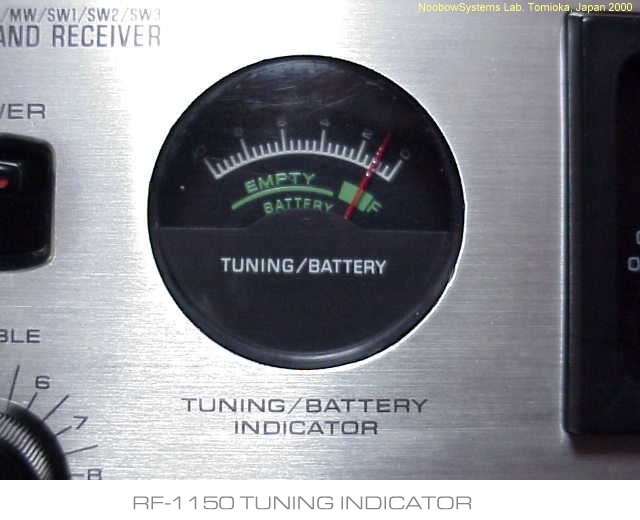 |
|||||||||||||||||||||||||||||||||||||||||||||||||||||||||||||||||||||||||
|
Audio and Speaker 16cm full range speaker provides rich audio, driven by the 2.2W output power. BASS and TREBLE tone control knob provides the adaptability to both FM music and shortwave DXing. Left side panel carries EARPHONE jack, STEREO-IN/REC-OUT jack, and MPX-OUT jack. It has a provision to the FM stereo. Power Supply RF-1150 runs with 4 "C" dry cell, or from AC 100V. LIGHT switch, which can be turned on while the lever is hold downward, provides illumination for the dial and indicator (meter). The receiver has a built-in 120 minutes ON-OFF mechanical timer unit. When the timer is in operation, the radio is powered up when the POWER switch is OFF. Therefore when the timer is up, the radio stops operation. Many transistor radios in this era had this kind of timer, because many young users loved to listen midnight talk programs - the must feature for the bedside radio. |
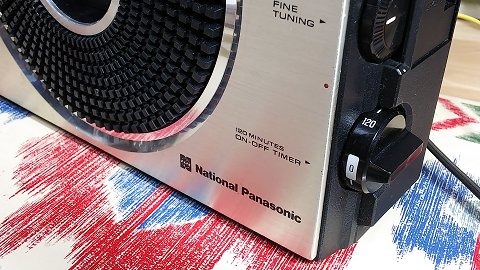 |
|||||||||||||||||||||||||||||||||||||||||||||||||||||||||||||||||||||||||
|
This receiver is not good at receiving weak signals.
Receiver noise and intermodulation tends to obscure the weak incoming signal.
Also it is vulnerable to the nearby computer noise. Image interference is quite obvious in this single superhet. Many broadcasting station can be heard in the 28-30MHz portion of the dial, but they are the 2nd harmonics of 15MHz band broadcasting. Frequency stability is satisfactory for broadcasing, but quite inadequate for CW or SSB reception. In addition to somewhat constant frequency drift, CW tone becomes very chirpy and buzzy. CW reception audio of RF-1150 (MP3) Power suppy voltage variance is one of the causes of the frequency drift. If LIGHT switch is turned on while receiving the SSB, drift is immediately obvious. I'm not sure if local oscillator and BFO are supplied with voltage regulator, for I don't have the schematic. If not so, adding voltage regulator would improve the stability. After all, the RF-1150 is not a serious DXer's radio. For international broadcasting with at least moderate signal strength, however, it admirably plays. The sound from 16cm speaker is quite smooth and rich, especially the full-bodied bass. Clear high tone may be also enjoyed with treble control up, if there's no adjacent interference. Now I find the RF-1150 being one of the best receiver for my purpose - relax and enjoy the cozy listening of my favorite shortwave programs. |
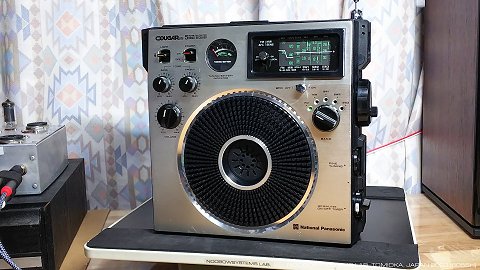 |